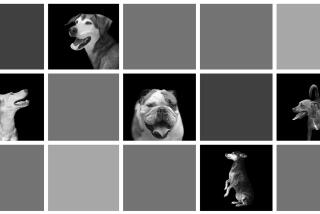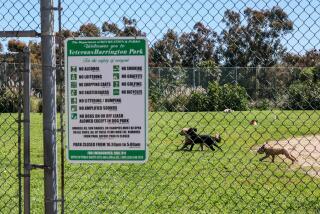Review: âDogTownâ: âThe Michael Vick Dogsâ
It has been a summer of awe-inspiring, thought-provoking spectacle on television. First the Summer Olympics, then the Democratic and Republican national conventions and now the return of âDogTown.â If that sounds sarcastic or snarky, it isnât meant to. The two-hour season premiere of the popular National Geographic Channel show is titled âSaving the Michael Vick Dogs,â and if there were such a thing as an Olympics for animal rescue and rehabilitation, this would be it.
Last December, the Atlanta Falconsâ star quarterback Michael Vick was sentenced to 23 months in prison for operating an illegal dog fighting venture on his Virginia property. Forty-seven pit bulls in various states of physical and psychological damage were found at Vickâs Bad Newz Kennels; eight more corpses were discovered buried nearby.
At the time, many animal rescue experts recommended that the dogs be put down; so traumatic had the abuse been, so long had been their imprisonment that rehabilitation seemed impossible.
Others, including the veterinarians and trainers at Utahâs Best Friends Animal Society, argued that the dogs could be saved. A judge finally agreed, and more than half were turned over to various shelters and rescues; the 22 most troubled dogs were sent to Dogtown.
Located on 3,000 acres of canyon country in southern Utah, the Best Friends sanctuary is one of the largest and no doubt the most beautifully located no-kill animal facilities; Dogtown is its canine program. For the past two years, âDogTownâ the show has chronicled the staff as it healed and trained various ill, hurt, abused, abandoned and behavior-issue-plagued dogs.
In other words, itâs a hard-core dog-lovers kind of show.
But even those folks who have never adopted a dog, loved a dog, pet a dog or met a dog will sit riveted as the four toughest cases of the Vick survivors are brought back from what can be described only as the brink of torture-inflicted canine insanity.
Thereâs Cherry, an animal so terrified of people he cannot even walk when a human is around. His perpetually cowering stance convinces assistant dog care manager John Garcia and veterinarian Patti Iampietro that he must have been used as a âbait dogâ to train the champions. Denzel is anemic and ill, and no one can figure out whatâs wrong. Meryl is so hyper-aggressive toward humans that the court has ordered she must always stay at Dogtown, while Georgia cannot be around other dogs without attacking. And no wonder. Her scars indicate she was possibly a âchampionshipâ fighter, which explains why she has been bred repeatedly and abusively -- at some point, all her teeth were removed to make, as Iampietro surmises, the forced breeding less dangerous to the other dog.
So if you ever wondered how bad dog fighting is, hereâs your answer. To its everlasting credit, âDogTownâ does not sensationalize the abuse; the histories of the dogs are simply pieced together from behavior patterns and physical evidence, which is much more chilling and effective. And while Garcia and dog care manager Michelle Besmehn are clear in their condemnation of the âsport,â they are more concerned with proving that pit bulls are not by nature dangerous animals and that even severely abused dogs can become loving pets for the proper owners.
The goal in each case -- save Merylâs -- is adoption, but âDogTownâ does not offer some miraculous âbefore and afterâ cure. Instead, viewers are taken through the painstaking process of first reaching the animals, earning their trust and then training them to behave with control in the Dogtown environment. In one story thread, Besmehn is drawn to Cherry because he is shy like her, and she spends the better part of a day just sitting with the dog and sees extraordinary progress when Cherry sniffs her coat and her arm.
That kind of quiet patience in both Besmehn and Garcia, and the pleasure they take in each tiny step toward recovery, acts as a necessary reminder that not all feats of heroism can be measured by broken world records or soaring rhetoric or the tears of a grateful nation. Sometimes just the image of two dogs playing, because they are finally capable of play, is spectacular enough.
More to Read
The biggest entertainment stories
Get our big stories about Hollywood, film, television, music, arts, culture and more right in your inbox as soon as they publish.
You may occasionally receive promotional content from the Los Angeles Times.











